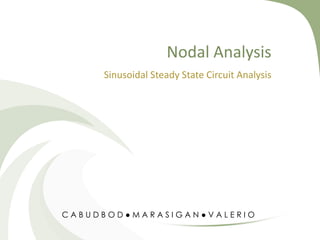
Nodal analysis
- 1. Nodal Analysis Sinusoidal Steady State Circuit Analysis CABUDBOD●MARASIGAN●VALERIO
- 2. Nodal Analysis • The node-voltage method is based on following idea.Instead of solving for circuit variables, • i and v of each element, we solve for a different set of parameters, node voltages in this case, • which automatically satisfy KVLs.As such, we do not need to write KVLs and only need to solve KCLs.
- 3. Nodal Analysis • Nodal analysis is more commonly used than mesh or loop analysis for analysing networks. • It can be used to determine the unknown node voltages of both planar and non-planar circuits. • Nodal equations are usually formed by applying Kirchoff’s Current Law to the nodes with unknown voltages, whereas equations based on Kirchoff’s Voltage
- 4. Nodal Analysis • In order to apply nodal analysis to a circuit, the first step is to select a reference node or datum node and then assign a voltage at each of the other nodes with respect to the reference node.
- 5. Procedure in Nodal Analysis • Select a reference node and treat it to be at zero or ground potential. • Label the nodes with unknown voltages. • At each of these nodes, mark currents in the elements as flowing away from • the node. • Form KCL equations and solve the set of simultaneous equations for the • unknown voltages.
- 6. Nodes • Node refers to any point on a circuit where two or more circuit elements meet. For two nodes to be different, their voltages must be different. Without any further knowledge, it is easy to establish how to find a node by using Ohm's Law: V=IR. When looking at circuit schematics, ideal wires have a resistance of zero. Since it can be assumed that there is no change in the potential across any part of the wire, all of the wire in between any components in a circuit is considered part of the same node.
- 8. Answer Va=64
- 9. Nodes with same voltage • In this circuit diagram the voltage in the green node is the samethroughout, likewise, the voltages in the blue node and the red node are the same throughout.
- 10. Enter vs. Leaving • Ienter = Ileaving • Node equation: I1 + I2 = I3, • As you can see I1 and I2 are entering the node and I3 is exiting the node. If we move I3 to the left side of the Node equation, then the node equation becomes, • Node equation: I1 + I2+ (I3) = 0
- 11. Sample Problem
- 12. Sinusoid-phasor transformation • Solution: • We first convert the circuit to the frequency domain:
- 14. • These equations may be written in terms of the ratio of the phasor voltage to the phasor current as • jωL is equivalent impedance of a an inductor in phasor analysis.
- 15. Sample Problem
- 22. Sample Problem
- 23. Answer ix = 7.59 cos(4t + 108.4◦) A
- 24. Supernodes • In circuit theory, a super-node is a theoretical construct that can be used to solve a circuit. This is done by viewing avoltage source on a wire as a point source voltage in relation to other point voltages located at various nodes in the circuit, relative to a ground node assigned a zero or negative charge. • Each super-node contains two nodes, one a non-reference node and another node that may be a second non-reference node or the reference node. Super-nodes containing the reference node have one node voltage variable. For Nodal circuit analysis, the super-node construct is only required between two non-reference nodes.
- 27. Answer 25.78 − 70.48◦ V